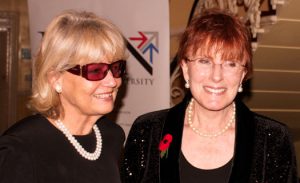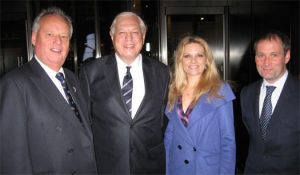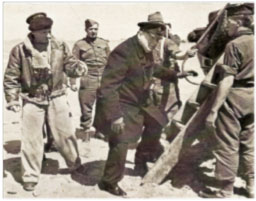
Bulletin #53 - Nov 2012
Jack Ford Rediscovers Trove of WWII Photos
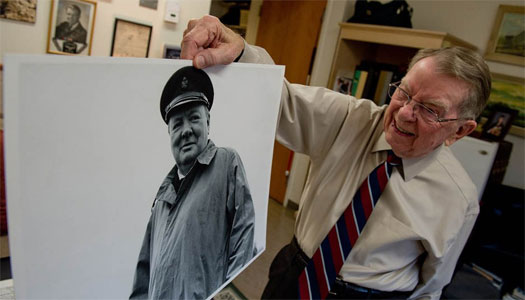
November 7, 2012
Churchill, King George, and downed Nazi planes: Decades after documenting the war, photos are rediscovered. 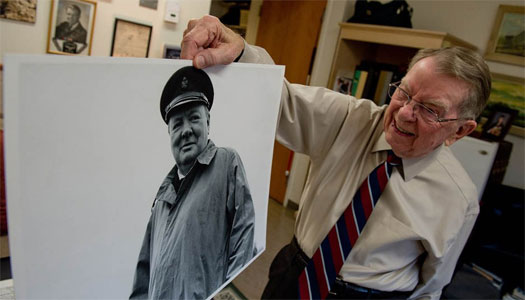 Jack Ford shows off part of his collection
Jack Ford shows off part of his collection
By Joe O’Connor
THE NATIONAL POST, 2 November 2012 — Some of the details of that long ago day are smudged, blurred by the almost 70 years that have passed since Jack Ford found himself at an Allied airstrip in France, a few weeks after the D-Day landings, fumbling with his camera, fighting nerves, aiming his lens at Sir Winston Churchill.
Mr. Ford later became a Mad Man – a deal-maker, vice-president of what was then MacLaren Advertising, the largest ad firm in Canada. But at the time, he was “Private Nobody,” he says, a lowly soldier, only even lowlier than most soldiers because he carried a camera and film canisters for RCAF Squadron 414’s Photo Unit instead of a gun.
On that June day in France, however, he was in the middle of the action. Listening as the question — “Could you let me take your picture before you put that cigar in the mouth?” — passed from his lips to the ears of a British Prime Minister famous for giving stirring speeches and perhaps even more famous for being photographed with a stogie clenched between his teeth and a scowl on his face.

2025 International Churchill Conference
“Three planes had arrived that day and we didn’t who it was,” Mr. Ford says, hopping about his room in Sunnybrook hospital’s veterans wing, pantomiming the Prime Minister’s reaction to his anti-smoking request. “We were told to grab our cameras. It was Churchill, [Field Marshal Bernard Law] Montgomery and King George VI. It was Churchill — and the King!
“And I was scared s—less, and Churchill, he was just staring at me and so his handler says, ‘What’s the problem, Sonny?’ I told him I wanted a picture without the cigar and so Churchill hands it to his handler, makes a face at me and then…”
He smiled, or he almost did, for a young Canadian war photographer in a never-before-published photograph that would languish, for decades, in a box in Mr. Ford’s basement. The picture is a forgotten wartime treasure, and just one among thousands taken by Mr. Ford and the other photographers and Spitfire pilots of Squadron 414 while they advanced across Western Europe.
Looking at the pictures now is a form of therapy, Mr. Ford says, a trip down memory lane that has brought new meaning to a long rich life.
The old war photographer moved into the hospital two years ago. His wife, Joan, suffers from advanced Alzheimer’s and was moved into a different facility. The couple had never really been apart.
“I was really down at first,” Mr. Ford says, spry and nimble at 91. “My wife doesn’t even know who I am anymore. I have my moments where there are tears, times when I close my door, but going through all these old pictures and remembering those times gives me great satisfaction.”
On Sunday, Jack Ford will be the keynote speaker at an event at the Canadian Aviation and Space Museum in Ottawa. His black leather portfolio case was packed well in advance of the trip. Inside was an array of talking points — enlarged black and whites — including the Churchill portrait and the next image in the series showing the British PM, cigar back in hand, fishing for a match in his breast pocket.
There are more: Aerial views of bombed out and still burning German targets; German POWS; Dutch children in wooden clogs, clustering around Canadian troops; an American bomber crash landing — the pilot dead, four more wounded inside; a rakish looking Mr. Ford bathing in the husk of a German fighter and hundreds of other images he won’t be taking to Ottawa, including a photo of a mass grave at the Bergen-Belsen concentration camp and another of a beautiful young woman lying naked, lifeless in the mud.
“I won’t be showing those to anyone,” Mr. Ford says. “They are too upsetting, and I wouldn’t want to upset the ladies.”
When he got home from the war Mr. Ford threw away his uniform. He wanted to forget, to start living life. He married a pretty girl, became a successful advertising executive, had three kids and a box of old war photographs stashed away in his basement.
Looking at them now, his eyes crinkle.
“I’m nearly blind,” Mr. Ford says. “But when I saw [the Churchill photo] I thought, holy smokes. It really is a great shot, isn’t it?”
Visit the National Post website to read the full article and see a selection of Mr Ford’s photos.
©National Post. All rights reserved.
Subscribe
WANT MORE?
Get the Churchill Bulletin delivered to your inbox once a month.

